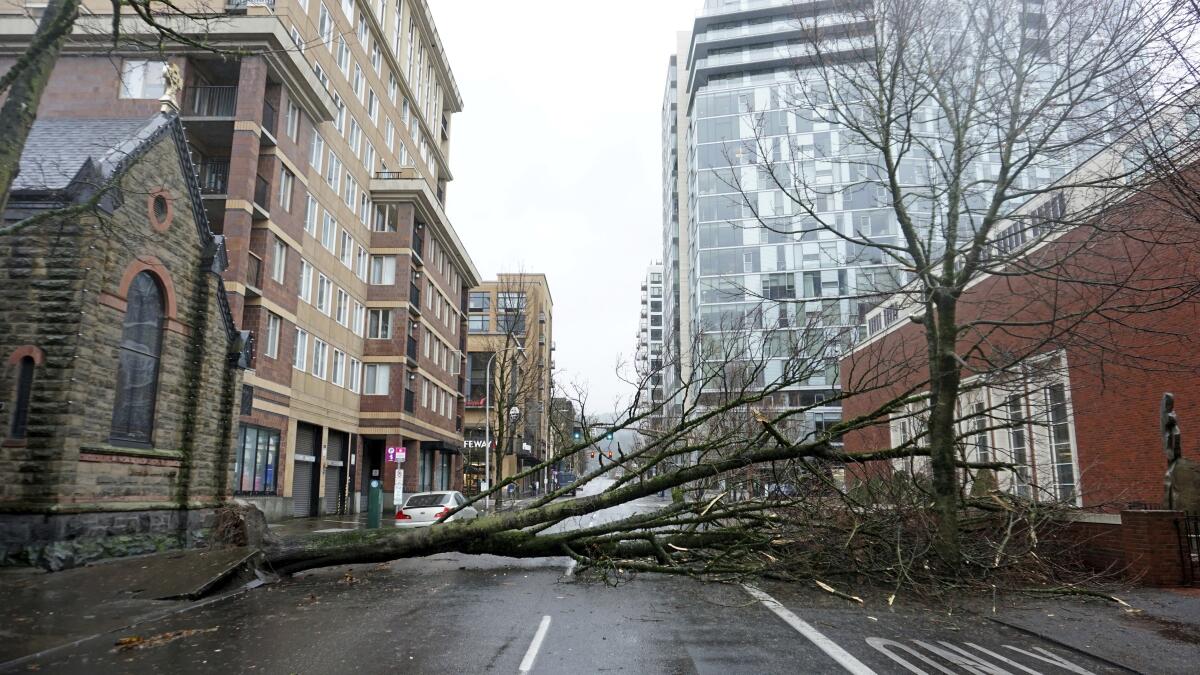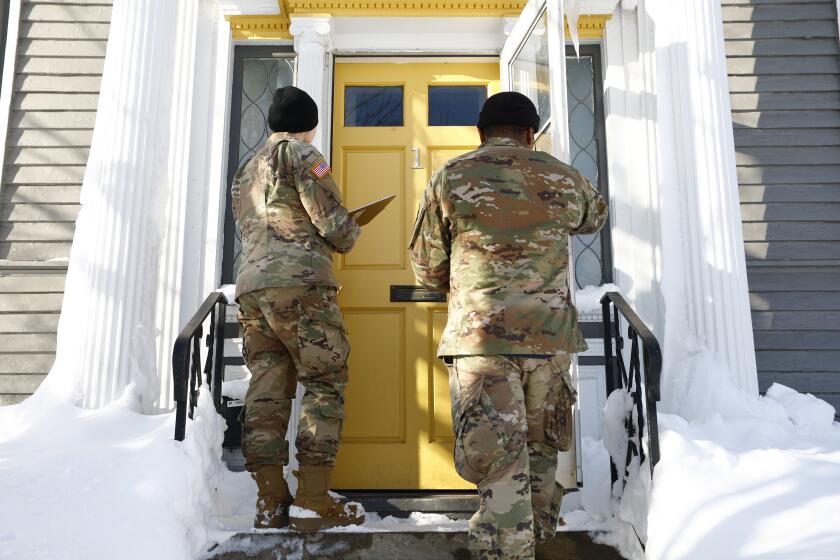Waves and winds batter Northwest, causing fatal crashes, power outages and flooded homes

- Share via
PORTLAND, Ore. — Monster waves, high tides and strong winds battering western Oregon and Washington led to fatal crashes, power outages and flooded homes on Tuesday.
Oregon State Police said multiple people died when their car hit a tree on U.S. 26 east of Cannon Beach, the Oregonian/OregonLive reported.
Investigators are determining whether the tree fell on the roadway before the car hit it or if the tree crushed the vehicle when it fell, police said. The exact number of people killed wasn’t immediately known.
Another motorist was killed when a tree fell and struck their vehicle while driving farther east on U.S. 26, KATU reported, citing Oregon State Police. More than 50 miles of the highway was shut down because of that crash, downed trees and high winds — from Rhododendron to Warm Springs, state transportation officials said.
In Washington, high tides known as king tides and heavy rains caused water to spill into more than a dozen homes in Seattle’s South Park neighborhood, the Seattle Times reported.
Reasmey Choun, who lives on the ground level of a two-story home in the neighborhood, woke up before 8 a.m. to the sound of water coming inside. Within an hour, it had settled above the doorknob of the front door.
The deep freeze that blanketed most of the U.S. in the last few days killed dozens of people and temporarily plunged millions into darkness.
Choun, her mother, niece and dog escaped through a window wearing robes and slippers, and got into her mother’s SUV that was parked on higher ground.
Choun went back inside to grab her laptop for work, but everything else — the carpet, the furniture, her birth certificate — was submerged or floating.
“We lost everything,” Choun said.
The stormy conditions gripped the Pacific Northwest as other parts of the nation are reeling from a ferocious winter storm that killed dozens.
Thirty-foot waves were expected to break along the entire Oregon coast on Tuesday, the National Weather Service said, with wave heights possibly topping 40 feet on the north coast.
“In situations like this, we recommend that people stay off the beach entirely,” said Brian Nieuwenhuis, a meteorologist with the National Weather Service’s Medford office. “I’d be very concerned about anybody going out on the beach and very concerned about any infrastructure located close to the surf zone.”
As of Tuesday afternoon, Oregon led the country as the state with the highest number of reported power outages — with more than 160,000 customers affected — according to online tracker PowerOutage. Along Oregon’s north coast, winds hit 80 mph. In the Portland metro area, wind gusts of 60 mph downed powered lines and felled trees, including near the Portland Art Museum downtown.
The National Guard is going door to door in parts of Buffalo to check on people who lost power during western New York’s deadliest winter storm in decades.
Compared to other utility companies, Portland General Electric reported the most outages, with more than 115,000 customers affected as of 3 p.m.
“These winds are blowing debris into our lines, taking down trees and damaging high-voltage transmission lines,” Dale Goodman, PGE director of utility operations, said in a statement. “The sustained winds make it challenging for crews to safely work in bucket trucks and on high wires.”
He said even with more than 600 personnel and contract crews, and with additional crews headed to help from California, Idaho and Washington, it will take time to assess damage, repair and restore power because of the extent of the damage and the winds.
Utility company Pacific Power said that over 250 field and support personnel, also including service crews from out of state, were assessing and repairing damage.
Coastal flooding and high wind advisories were also in effect for much of western Washington state.
A record high tide of 18.4 feet submerged parts of the state capital of Olympia, sweeping marine life into the city’s streets, officials said.
“Jellyfish washed over the shoreline and into our streets,” said Olympia Water Resources Director Eric Christensen. “There was a woman who was kind enough to rescue them and put them back into Budd Inlet.”
Other areas around Puget Sound also saw flooding, which trapped cars and affected buildings.
Tens of thousands of people in western Washington also were affected by power outages Tuesday afternoon, according to PowerOutage.
The weather conditions also forced the full or partial closure of several Oregon state parks at a time when whale watchers and holiday tourists typically flock to the coast.
Oregon State Parks announced emergency closures for Ecola and Cape Meares because of high winds and the potential for falling trees. The day-use area at Sunset Bay State Park near Coos Bay was closed because of extreme high tides and flooding.
Cape Meares is one of 17 sites hosting Oregon’s Whale Watch Week, which is returning in-person this year for the first time since the pandemic. During the event, which starts Wednesday and lasts through Sunday, volunteers help visitors spot gray whales during their annual migration south.
The park anticipates reopening on Wednesday, but people are advised to visit later in the week if possible, said Oregon State Parks spokesperson Stefanie Knowlton.
More to Read
Sign up for Essential California
The most important California stories and recommendations in your inbox every morning.
You may occasionally receive promotional content from the Los Angeles Times.















